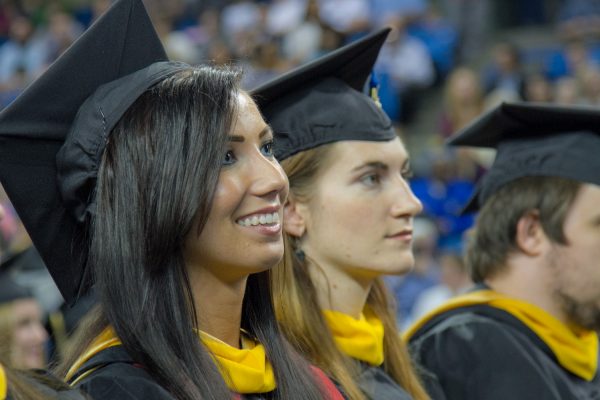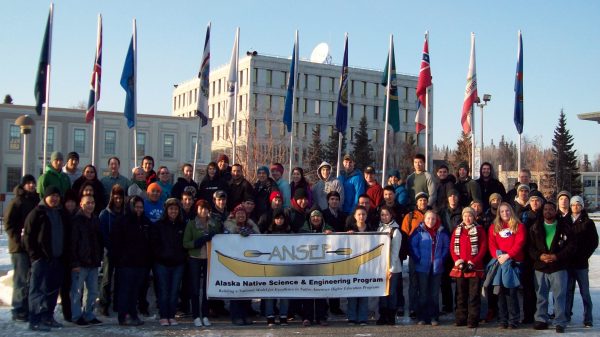UAF science program spurs rural Alaska success stories
April 17, 2018
Meghan Murphy
907-474-6941

Download text and photo captions here.
Brett Kirk grew up without ever seeing cars drive into or away from his hometown of Noatak in Northwest Alaska. But he did see planes land on and depart from a long, gravel airstrip within the Inupiat village.
After studying civil engineering at the University of Alaska Fairbanks, the senior will soon graduate with aspirations to design and improve airports for Alaska’s rural communities.
While Kirk’s upbringing and ambition fueled his journey, he said UAF’s Alaska Native Science and Engineering Program helped foster his college success by providing a home away from home.
“It feels like a community,” he said. “It almost feels like I’m at a village back in the school system, only the subjects are a little more challenging and the faces not as familiar. But has really diversified my understanding of university.”
Kirk and about 20 other students are currently part of ANSEP, a program within UAF’s College of Natural Science and Mathematics. ANSEP focuses on helping Alaska Natives, especially those from rural areas, succeed in college and prepare for careers in science, technology, engineering and math fields.
ANSEP director and chemistry professor Brian Rasley said the program offers opportunities for scholarships, academic and social support.
“Students that come to Fairbanks from rural Alaska are a long ways from home,” he said. “They may need help transitioning to college life or catching up on math and other subjects. We support them and help them build a community where they can support each other.”
As part of ANSEP, students are co-enrolled in classes whenever possible. They attend weekly meetings in addition to weekly study sessions where they mentor one other. There are also fun social activities interspersed between academics.

Organizing these meetings and gently reminding students to attend them are some of many tasks belonging to ANSEP coordinator Robin Weinant. She’s learned a trick or two after working almost 10 years with the program. Free lunches and sweets of generous proportions accompany the weekly meetings.
She invites guest speakers to the meetings to talk about their careers in STEM fields. She also helps place students in summer internships where they can gain work experience and build their resumes.
But she said sometimes her most important task is just to check in on a student she hasn’t seen in awhile and say, “Are you OK?”
“We really trying to get to know our students,” she said. “We try to provide a welcoming environment, and I know all their names and know what their interests are. We try to provide a community and home for them to come to that they might be missing from their rural village.”
CNSM helped develop ANSEP at the Fairbanks campus in 2002. ANSEP is also at the University of Alaska Southeast, but the program originated at University of Alaska Anchorage in 1995 with a single student. Since then, it has evolved into a robust program for students in middle school, high school and college, both at the undergraduate and graduate level.
So far, 169 undergraduate and graduate students have graduated from the Fairbanks-based program. Ten more students are due to graduate this spring and summer.
Julieanna Potter, who came to UAF from Palmer and earned a master's degree in 2011, participated in ANSEP as both an undergraduate and graduate student.

She said an undergraduate internship arranged through ANSEP helped her pursue graduate school. Potter interned in a UAF research lab and then worked there part-time under the guidance of UAF professor Kristin O’Brien. Potter eventually pursued a master’s degree in biochemistry and molecular biology with O’Brien as her advisor.
“I wouldn’t have gone to graduate school if it hadn’t been for ANSEP,” she said. “I didn’t have the connections, confidence or knowledge to start the process of finding and connecting with research internships. So ANSEP bridged that gap for me.”
Potter said the internship benefitted both her and O’Brien because ANSEP helped fund Potter’s work in the lab, which then furthered the research. ANSEP also provided financial assistance to Potter as a graduate student.
Today, Potter works as an environmental specialist for the oil and gas company Hilcorp Alaska LLC in Anchorage. She said getting her master’s degree opened up job opportunities, even ones beyond her field of study.
Carlton Hautala would like to follow a similar path. The fisheries major wants to become a graduate student at UAF to study the Pacific salmon system in the Yukon-Kuskokwim Delta where his family lives and practices subsistence fishing.
Hautala said he appreciates the opportunities ANSEP funnels to its students, especially during the weekly meetings when invited speakers talk about their road to a successful STEM career.
“It’s a good environment to stay positive in,” he said.


